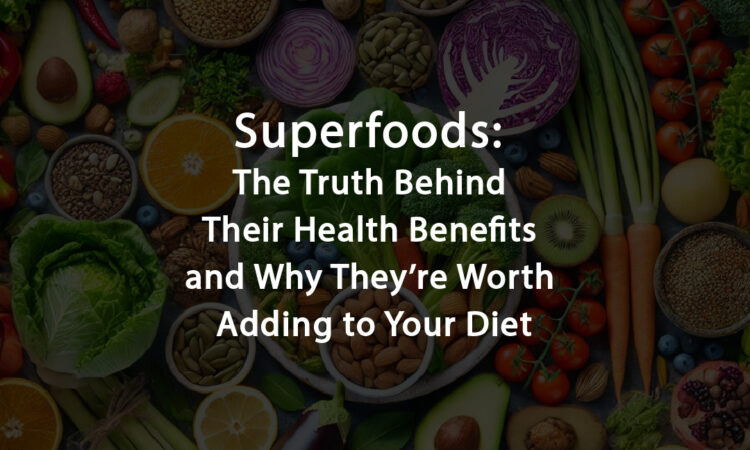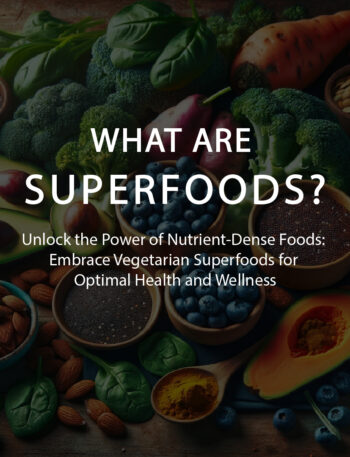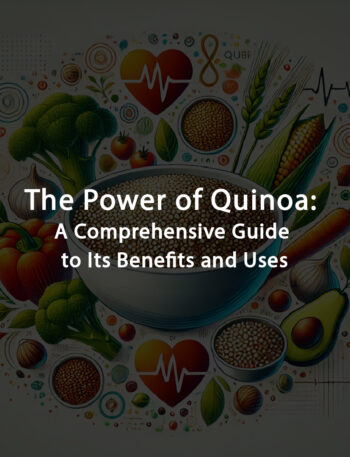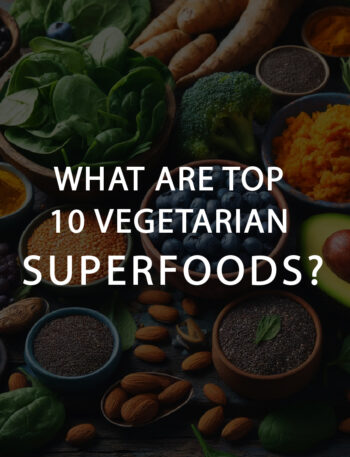In recent years, superfoods have taken the health and wellness world by storm. They are hailed as nutrient powerhouses that can provide incredible health benefits, from boosting energy levels and improving digestion to preventing chronic diseases and enhancing overall well-being. But what exactly are superfoods? Are they really as extraordinary as they are made out to be, or is the term just another marketing gimmick?
In this comprehensive article, we will delve into what superfoods are, examine the science behind their health claims, explore some of the most popular superfoods, and discuss whether they are truly worth the hype. We will also provide tips on how to incorporate them into your diet and suggest some lesser-known superfoods that are just as beneficial.
What Are Superfoods?
The term “superfood” is not a scientific classification but rather a marketing term used to describe foods that are believed to offer maximum nutritional benefits for minimal calories. They are typically rich in vitamins, minerals, antioxidants, and other nutrients that are thought to be beneficial for health. Superfoods are often associated with plant-based foods, but the category can also include some fish and dairy.
Characteristics of Superfoods
Superfoods typically share several key characteristics:
- Nutrient Density: Superfoods are packed with nutrients relative to their calorie content. They provide essential vitamins, minerals, and antioxidants that support overall health.
- Antioxidants: Many superfoods are rich in antioxidants, compounds that help protect the body from oxidative stress and reduce inflammation.
- Health Benefits: Superfoods are believed to offer various health benefits, such as boosting the immune system, reducing the risk of chronic diseases, and improving digestion.
- Whole Foods: Most superfoods are minimally processed and come in their natural form, making them a healthy addition to any diet.
The Science Behind Superfoods
While many superfoods have been shown to have health benefits, it is important to approach their claims with a critical eye. The effectiveness of superfoods depends on their nutrient content and how they are consumed within the context of a balanced diet. Here’s a look at some of the science behind superfoods:
Antioxidants and Inflammation
Antioxidants are compounds that neutralize free radicals, unstable molecules that can damage cells and contribute to aging and diseases such as cancer and heart disease. Superfoods like blueberries, green tea, and dark chocolate are rich in antioxidants such as flavonoids, polyphenols, and vitamins C and E. Studies have shown that consuming foods high in antioxidants can help reduce oxidative stress and inflammation, which are linked to chronic diseases.
Fiber and Digestion
Fiber is another key component of many superfoods. Foods like chia seeds, flaxseeds, and oats are high in both soluble and insoluble fiber, which aid in digestion, help maintain healthy blood sugar levels, and support heart health. A diet high in fiber has been linked to a lower risk of developing conditions like type 2 diabetes, heart disease, and colon cancer.
Essential Fatty Acids
Superfoods such as chia seeds, walnuts, and fatty fish like salmon are rich in omega-3 fatty acids, which are essential for brain function and reducing inflammation. Omega-3s have been shown to lower the risk of heart disease, reduce symptoms of depression, and support overall cognitive health.
Phytochemicals
Phytochemicals are naturally occurring compounds found in plants that can have various health benefits. Superfoods like turmeric, which contains the phytochemical curcumin, have been shown to have anti-inflammatory and antioxidant effects. Similarly, green tea contains catechins, which are associated with improved metabolic health and fat oxidation.
Popular Superfoods and Their Benefits
Now that we understand what makes a food “super,” let’s explore some of the most popular superfoods and the science behind their health claims.
1. Blueberries
Nutritional Profile: Blueberries are low in calories but high in fiber, vitamin C, vitamin K, and antioxidants like anthocyanins.
Health Benefits:
- Cognitive Health: Studies have shown that the antioxidants in blueberries can delay brain aging and improve cognitive function.
- Heart Health: Regular consumption of blueberries has been linked to reduced blood pressure and improved cholesterol levels.
- Anti-Inflammatory Effects: The antioxidants in blueberries can help reduce inflammation in the body, which is linked to chronic diseases.
How to Incorporate: Add blueberries to smoothies, oatmeal, yogurt, or salads for a nutritious boost.
2. Chia Seeds
Nutritional Profile: Chia seeds are rich in fiber, protein, omega-3 fatty acids, and various micronutrients like calcium, magnesium, and phosphorus.
Health Benefits:
- Digestive Health: The high fiber content in chia seeds supports healthy digestion and can help prevent constipation.
- Heart Health: Omega-3 fatty acids in chia seeds can help lower blood pressure and reduce the risk of heart disease.
- Weight Management: Chia seeds absorb liquid and expand in the stomach, promoting a feeling of fullness and reducing appetite.
How to Incorporate: Mix chia seeds into smoothies, yogurt, or oatmeal, or use them as a base for chia pudding.
3. Kale
Nutritional Profile: Kale is one of the most nutrient-dense foods available, packed with vitamins A, C, and K, as well as antioxidants and fiber.
Health Benefits:
- Bone Health: High levels of vitamin K support bone health and reduce the risk of fractures.
- Detoxification: Kale contains compounds that support the body’s natural detoxification processes.
- Cancer Prevention: Some studies suggest that the antioxidants and phytochemicals in kale may help reduce the risk of certain cancers.
How to Incorporate: Use kale in salads, smoothies, or sauté it with garlic and olive oil for a nutritious side dish.
4. Quinoa
Nutritional Profile: Quinoa is a complete protein, meaning it contains all nine essential amino acids. It is also high in fiber, iron, magnesium, and antioxidants.
Health Benefits:
- Protein Source: Quinoa is an excellent plant-based protein source, making it ideal for vegetarians and vegans.
- Blood Sugar Control: The fiber and protein in quinoa help regulate blood sugar levels and reduce the risk of type 2 diabetes.
- Digestive Health: High fiber content supports healthy digestion and regular bowel movements.
How to Incorporate: Use quinoa as a base for salads, bowls, or as a side dish in place of rice.
5. Green Tea
Nutritional Profile: Green tea is rich in antioxidants called catechins, particularly epigallocatechin gallate (EGCG), which has powerful health benefits.
Health Benefits:
- Metabolic Health: Green tea has been shown to boost metabolism and increase fat oxidation.
- Brain Health: Regular consumption of green tea may reduce the risk of neurodegenerative diseases like Alzheimer’s and Parkinson’s.
- Cancer Prevention: Some studies suggest that the catechins in green tea may help prevent certain types of cancer.
How to Incorporate: Enjoy a cup of green tea daily, or use matcha powder in smoothies or desserts.
6. Turmeric
Nutritional Profile: Turmeric contains curcumin, a compound with powerful anti-inflammatory and antioxidant properties.
Health Benefits:
- Anti-Inflammatory: Curcumin in turmeric can help reduce inflammation and may be beneficial for conditions like arthritis.
- Digestive Health: Turmeric supports digestive health by stimulating bile production.
- Heart Health: Curcumin may help improve endothelial function, which is important for heart health.
How to Incorporate: Add turmeric to curries, soups, or smoothies, or use it to make golden milk.
7. Dark Chocolate
Nutritional Profile: Dark chocolate is rich in antioxidants, particularly flavonoids, as well as iron, magnesium, and zinc.
Health Benefits:
- Heart Health: The flavonoids in dark chocolate can help lower blood pressure and improve cholesterol levels.
- Cognitive Function: Dark chocolate has been linked to improved cognitive function and mood.
- Antioxidant Protection: The antioxidants in dark chocolate can help protect against oxidative stress and inflammation.
How to Incorporate: Enjoy a small piece of dark chocolate as a treat, or add cacao nibs to smoothies and oatmeal.
8. Walnuts
Nutritional Profile: Walnuts are high in healthy fats, particularly omega-3 fatty acids, as well as protein, fiber, and various vitamins and minerals.
Health Benefits:
- Heart Health: The omega-3 fatty acids in walnuts can help lower blood pressure and reduce the risk of heart disease.
- Brain Health: Regular consumption of walnuts has been linked to improved cognitive function.
- Weight Management: Walnuts can promote a feeling of fullness and support healthy weight management.
How to Incorporate: Add walnuts to salads, oatmeal, or enjoy them as a snack.
9. Avocado
Nutritional Profile: Avocados are rich in healthy monounsaturated fats, fiber, potassium, and vitamins C, E, and K.
Health Benefits:
- Heart Health: The healthy fats in avocados can help lower LDL cholesterol and reduce the risk of heart disease.
- Weight Management: Avocados can promote satiety and help regulate appetite.
- Skin Health: The healthy fats and antioxidants in avocados support healthy, glowing skin.
How to Incorporate: Use avocados in salads, sandwiches, or as a base for guacamole.
10. Sweet Potatoes
Nutritional Profile: Sweet potatoes are high in beta-carotene, fiber, and vitamins A, C, and B6.
Health Benefits:
- Eye Health: Beta-carotene in sweet potatoes supports eye health and may reduce the risk of macular degeneration.
- Digestive Health: The fiber in sweet potatoes supports healthy digestion and regular bowel movements.
- Immune Support: The vitamins and antioxidants in sweet potatoes help support the immune system.
How to Incorporate: Roast sweet potatoes as a side dish, add them to soups and stews, or mash them as a healthier alternative to regular potatoes.
Are Superfoods Worth the Hype?
While superfoods offer numerous health benefits, it is important to remember that no single food can provide all the nutrients your body needs. The term “superfood” can sometimes be misleading, as it suggests that these foods are superior to others. In reality, a balanced diet that includes a variety of nutrient-dense foods is the best way to support overall health.
The Importance of a Balanced Diet
Superfoods can certainly enhance your diet, but they should be consumed as part of a balanced, varied diet that includes a wide range of fruits, vegetables, whole grains, lean proteins, and healthy fats. Relying too heavily on a few superfoods while neglecting other essential nutrients can lead to nutritional imbalances.
Moderation is Key
While superfoods are nutritious, they can also be high in certain nutrients like sugar or fat. For example, while dark chocolate is rich in antioxidants, it is also high in calories and fat, so it should be consumed in moderation. Similarly, consuming large amounts of foods like chia seeds or flaxseeds without adequate hydration can cause digestive discomfort due to their high fiber content.
Cost and Accessibility
Superfoods can sometimes be expensive and difficult to find, which can be a barrier for some people. However, many common foods like apples, carrots, and beans offer similar health benefits at a lower cost. It is important to choose foods that are affordable and accessible to you, rather than feeling pressured to buy expensive, trendy superfoods.
How to Incorporate Superfoods into Your Diet
Incorporating superfoods into your diet is easier than you might think. Here are some practical tips:
Start with One or Two
If you’re new to superfoods, start by adding one or two to your diet. For example, you can add a handful of blueberries to your breakfast or sprinkle chia seeds on your yogurt or smoothie.
Combine with Other Healthy Foods
Pair superfoods with other nutrient-dense foods to create balanced meals. For example, combine quinoa with roasted vegetables and a healthy fat like avocado for a nutritious, filling meal.
Experiment with Recipes
Try new recipes that feature superfoods. For example, you can make a kale and quinoa salad, a smoothie with spinach and chia seeds, or a turmeric-spiced lentil soup.
Use as Snacks
Superfoods make great snacks. Enjoy a handful of nuts, some dark chocolate, or a piece of fruit as a healthy snack between meals.
Lesser-Known Superfoods Worth Trying
While the superfoods mentioned above are popular and well-known, there are many lesser-known superfoods that offer incredible health benefits. Here are a few to consider:
1. Moringa
Moringa is a nutrient-dense plant that is high in vitamins A, C, and E, as well as calcium and protein. It has been used in traditional medicine to treat various ailments and is believed to have anti-inflammatory and antioxidant properties.
How to Use: Add moringa powder to smoothies, teas, or soups.
2. Spirulina
Spirulina is a type of blue-green algae that is rich in protein, iron, and B vitamins. It is often used as a supplement and is believed to support immune function, detoxification, and energy levels.
How to Use: Add spirulina powder to smoothies or take it in capsule form.
3. Baobab
Baobab is a fruit from the African baobab tree that is high in vitamin C, fiber, and antioxidants. It has a tangy flavor and can support digestion and immune function.
How to Use: Add baobab powder to smoothies, oatmeal, or yogurt.
4. Amaranth
Amaranth is an ancient grain that is high in protein, fiber, and various micronutrients. It is gluten-free and can be used in place of rice or quinoa.
How to Use: Cook amaranth as a side dish, add it to soups, or use it in baking.
5. Camu Camu
Camu camu is a berry that is one of the richest natural sources of vitamin C. It has powerful antioxidant properties and may support immune health and reduce inflammation.
How to Use: Add camu camu powder to smoothies or take it in supplement form.
Superfoods are a valuable addition to any diet, offering a wide range of health benefits thanks to their high nutrient density. However, it is important to remember that they are not a cure-all and should be part of a balanced, varied diet. Incorporating superfoods into your daily routine can help enhance your overall health and well-being, but moderation and balance are key.
Whether you choose popular superfoods like blueberries and quinoa or explore lesser-known options like moringa and spirulina, the most important thing is to enjoy a variety of nutrient-dense foods. By doing so, you can support your health in a delicious and sustainable way.






